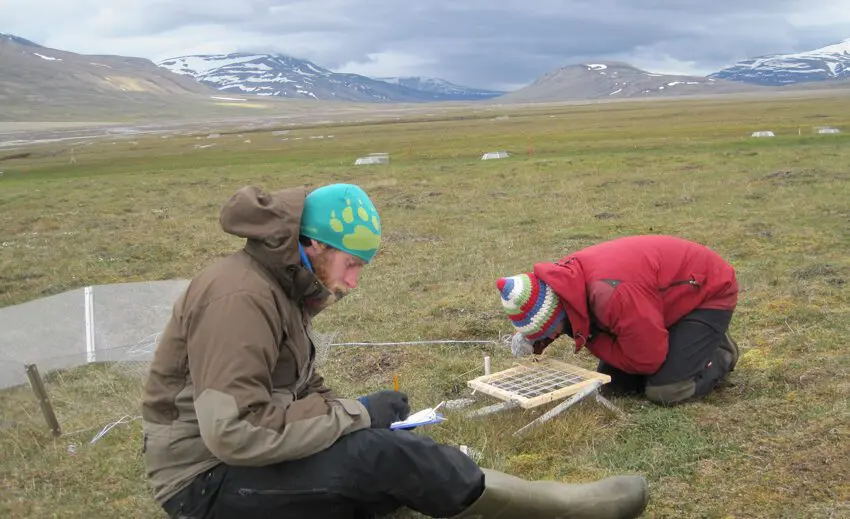Linking plant nutrient dynamics and ecosystem processes in a warmer Arctic

Matteo Petit Bon (right) is using point intercept method to assess the biomass in an undisturbing way, by counting and identifying plants within each square, which is then used to calculate how much biomass there is in each plot. Field assistant Cal Bachell keeps track of the findings. Photo: Eva Therese Jenssen/UNIS.
Top image: Matteo Petit Bon (right) is using point intercept method to assess the biomass in an undisturbing way, by counting and identifying plants within each square, which is then used to calculate how much biomass there is in each plot. Field assistant Cal Bachell keeps track of the findings. Photo: Eva Therese Jenssen/UNIS.
What effect will a warming climate have on plants in Svalbard? What about the increase of pink-footed goose population due to recent climate changes? Will a heated and more grazed Arctic mean more carbon emission or the opposite? UNIS PhD candidate Matteo Petit Bon aims at finding out.
21 July 2017
Text: Eva Therese Jenssen
The main aim of his PhD project in Arctic biology is to get a better understanding of plant and herbivore (plant-eating animals) interactions in a warmer Arctic. In particular, he is interested in how higher temperatures and heavier herbivory may influence nutrient dynamics in the tundra and how this can be linked with ecosystem processes such as instantaneous carbon exchange between ecosystem and atmosphere and decomposition rates.
In order to do so, he has set up a field experiment in Adventdalen, some kilometres outside Longyearbyen.
First, he investigates the effect of temperatures on plant nutrient dynamics. To this end, he has set up a number of open-top chambers, almost like small greenhouses, which contain heat better than the surroundings. It’s about 1,5 degrees C warmer inside the chambers than outside. Goose grubbing (herbivory) has been implemented by using a metal tube to simulate goose feeding patterns. He has also added goose faeces since herbivory does not occur without fertilization.
– It’s a factorial design with two components: warming and goose herbivory, Petit Bon explains.
In addition, the factorial design is replicated across three different environmental settings: dry, moist, and wet communities.
Vegetation is not a unique box, Petit Bon says.
– When studying the impact of climate changes in extreme environments, such as the High Arctic, it is important to consider the mosaic of vegetation communities and their different abiotic (non-living) characteristics. We can expect different responses from each community, he concludes.

Carbon sinks or carbon sources?
To finally link plant nutrient dynamics and ecosystem processes, he measures carbon fluxes in all plots in all three communities.
– In a warmer climate, one expects to find a change in the carbon exchange between ecosystem and atmosphere. In the Arctic, higher temperatures mean an increase in biomass (Carbon fixation), but also higher respiration from both plants and soil (Carbon emission). What is the net outcome of these two processes? Little is known, and patterns seem to be context-dependent, Petit Bon says.
Finally, we do know almost nothing on how geese and higher temperatures interact in modifying carbon exchange.
In other words, under this future scenario, will Arctic ecosystems be carbon sinks or carbon sources?
This has extremely important consequences on the global carbon cycle and on the overall climate system.
– If Arctic ecosystems are switching from carbon sinks to sources, we can expect a positive feedback on the climate system and temperatures will continue to rise even faster than before, Petit Bon remarks.

A final element he is investigating is the decomposition rates in the three different communities. Last summer he collected plant samples from species belonging to different plant functional types (groups of plants with different characteristics, hence affecting ecosystems in different ways) and put them in meshed plastic bags, placed them back in the three different communities, under the whole factorial design.
Later this summer the bags will be collected and weighed to see if there are any differences in decomposition based on treatment (warmer temperatures and simulated goose herbivory) and the environment they were put in (dry, moist or wet).
Petit Bon is concluding his fieldwork this summer and will analyse his data sets and write articles about his findings next year.